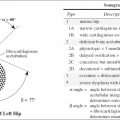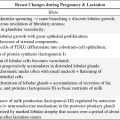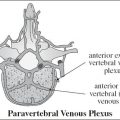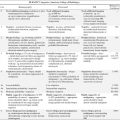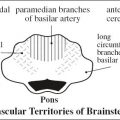GA ≥ 2 weeks more advanced sonographically than by clinical estimate (AFP levels rise 15% per week during 16–18-week window)
C. MULTIPLE GESTATIONS (14%)
D. FETAL DEMISE (7%) / fetal distress / threatened abortion
E. FETAL ANOMALIES (61%)
1. Neural tube defects (51%):
anencephaly (30%), myelomeningocele (18%), encephalocele (3%), forebrain malformation
Prevalence: 1.6÷1,000 births in USA; 6÷1,000 births in Great Britain
◊ In 90% as 1st time event!
Risk of recurrence: 3% after one affected child; 6% after 2 affected children
2. Ventral wall defects (21%):
gastroschisis, omphalocele (sensitivity of 50%)
3. Proximal fetal gut obstruction:
esophageal / duodenal atresia
→ diminished AFP degradation in small bowel
4. Cystic hygroma, teratoma: pharyngeal, sacral
5. Amniotic band syndrome:
asymmetric cephalocele, gastropleuroschisis
6. Renal abnormalities:
multicystic dysplastic kidney, renal agenesis, pelviectasis, congenital Finnish nephrosis → typically ≥ 10 MoM + negative amniotic fluid acetylcholinesterase
7. Oligohydramnios
F. PLACENTAL LESION
altering the placentomaternal barrier
1. Chorioangioma
2. Peri- and intraplacental hematoma
→ resulting in fetomaternal hemorrhage
3. Placental lakes, infarct, intervillous thrombosis
G. LOW BIRTH WEIGHT
H. Normal pregnancy + MATERNAL DISORDER
1. Hepatitis
2. Hepatoma
I. Fetal-maternal blood mixing:
collection of MS-AFP samples after amniocentesis
mnemonic: GEM MINER CO
Gastroschisis
Esophageal atresia
Multiple gestations
Mole
Incorrect menstrual dates
Neural tube defects
Error: laboratory
Renal disease in fetus: autosomal recessive polycystic kidney disease, renal dysplasia, obstructive uropathy, congenital Finnish nephrosis
Chorioangioma
Omphalocele
ELEVATED MATERNAL SERUM AFP (MS-AFP)
= defined as ≥ 2.5 MoM / equivalent to the 5th percentile: 4.5 MoM for multiple gestations
Power of detection at ≥ 2.5 MoM cutoff:
98% for gastroschisis
90% for anencephalic fetuses
75–80% for open spinal defects
70% for omphaloceles
Prevalence: 2–5% screen-positive rate (in 16% normal MS-AFP on retesting); 6–15% of fetuses have some type of major congenital defect; in 1.3÷1,000 tests fetal anomaly detected
◊ The higher the AFP elevation the higher the probability of fetal anomalies
◊ 20–38% of women with unexplained high MS-AFP (ie, in the absence of fetal abnormality) suffer adverse pregnancy outcomes (premature birth, preeclampsia, 2–4 x IUGR, 10 x perinatal mortality, 10 x placental abruption)!
ELEVATED AMNIOTIC FLUID AFP (AF-AFP)
= defined as ≥ 2 MoM (< 2 MoM has a 97% NPV)
Prevalence: < 10% of women with elevated MS-AFP and “unrevealing” level I US exam
• amniotic fluid also tested for karyotype + acetylcholinesterase (= neurotransmitter enzyme present when neural tissue is exposed)
◊ 66% of fetuses with ↑ maternal AF-AFP are normal!
◊ A targeted level II ultrasound exam will show fetal anomalies in 33%!
Low Alpha-fetoprotein
= MS-AFP ≤ 0.5 / AF-AFP ≤ 0.72 MoM
Prevalence: 3%
1. Autosomal trisomy syndromes: trisomy 21, 18, 13
◊ 20% of trisomy 21 fetuses are found in women with low MS-AFP after adjustment for age!
2. Absence of fetal tissues: eg, hydatidiform mole
3. Fetal demise
4. Misdated pregnancy
5. Normal pregnancy
6. Patient not pregnant
Use of Karyotyping
Frequency: 11–35% of fetuses with sonographically identified abnormalities have chromosomal abnormalities
A. FETAL ANOMALIES
1. CNS anomalies: holoprosencephaly (43–59%), Dandy-Walker malformation (29–50%), cerebellar hypoplasia, agenesis of corpus callosum, myelomeningocele (33–50%)
2. Cystic hygroma (72%): Turner syndrome
3. Omphalocele (30–40%)
4. Cardiac malformations
5. Nonimmune hydrops
6. Duodenal atresia
7. Severe early-onset IUGR: trisomy 18, 13, triploidy
8. Congenital diaphragmatic hernia
9. Bone-echodense bowel (20%): trisomy 21
B. MATERNAL RISK FACTORS
1. Advanced age
2. Low serum alpha-fetoprotein
3. Abnormal triple screen of maternal serum
4. History of previous chromosomally abnormal pregnancy (1% risk of recurrence)
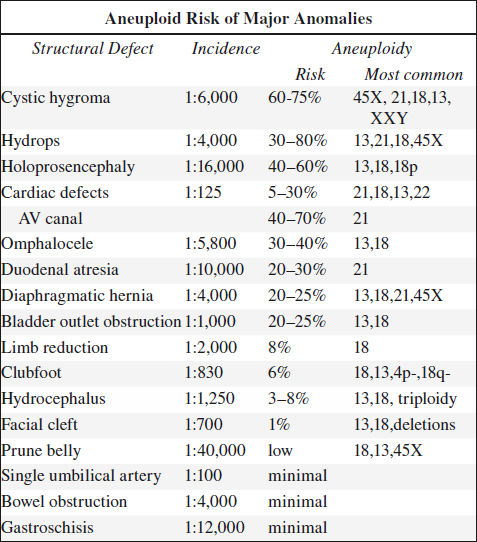
C. PLANNED INTENSE INTRAUTERINE MANAGEMENT
Fetal anomalies not associated with chromosomal anomalies:
1. Gastroschisis
2. Unilateral renal anomaly
3. Intestinal obstruction distal to duodenal bulb
4. Off-midline unilateral cleft lip
5. Fetal teratoma: sacrococcygeal / anterior cervical
6. Isolated single umbilical artery
AMNIOTIC FLUID VOLUME
Production:
(a) 1st trimester: dialysate of maternal + fetal serum across the noncornified fetal skin
(b) 2nd + 3rd trimester: fetal urine (600–800 cm3/d near term), fetal lungs (600–800 cm3/d near term), amniotic membrane
Absorption:
fetal swallowing + GI absorption, fetal lung absorption, clearance by placenta
Assessment of amniotic fluid volume by:
(1) Subjective assessment (“Gestalt” method):
quick + efficient, accounts for GA-related variations in fluid volume, considered the most accurate if performed by experienced operator, operator + interpreter must be identical, no documentation, variations on serial scans difficult to appreciate
(2) Depth of largest vertical pocket:
simple + quick (used in BPP), pockets > 2 cm may be found in crevices between fetal parts with moderately severe oligohydramnios, does not account for GA-related variations
(3) Four-quadrant Amniotic Fluid Index (AFI):
fairly quick, probably correlates better with fluid volume than any single measurement, may not accurately reflect overall fluid volume, may be affected by fetal movement during measurements
(4) Planimetric measurement of total intrauterine volume
(5) Dye / para-aminohippurate dilution technique:
800 cm3 at 34 weeks, 500 cm3 > 34 weeks
Polyhydramnios
= amniotic fluid volume > 1,500–2,000 cm3 at term
Prevalence: 1.1–2–3.5%
√ fetus does not fill the AP diameter of uterus
√ single largest pocket devoid of fetal parts / cord > 8 cm in vertical direction
√ AFI ≥ 20–24 cm
Prognosis: 64% perinatal mortality with severe polyhydramnios
Etiology:
A. IDIOPATHIC (35%)
Associated with: macrosomia in 19–37%
Suggested cause:
(1) Increased renal vascular flow
(2) Bulk flow of water across surface of fetus + umbilical cord + placenta + membranes
B. MATERNAL CAUSES (36%)
1. Diabetes (25%)
2. Isoimmunization: Rh incompatibility (11%)]
3. Placental tumors: chorioangioma
C. FETAL ANOMALIES (20%)
(a) gastrointestinal anomalies (6–16%):
impairment of fetal swallowing (esophageal atresia in 3%); high intestinal atresias / obstruction of duodenum / proximal small bowel (1.2–1.8%), omphalocele, meconium peritonitis
(b) nonimmune hydrops (16%)
(c) neural tube defects (9–16%):
anencephaly, hydranencephaly, holoprosencephaly, myelomeningocele, ventriculomegaly, agenesis of corpus callosum, encephalocele, microcephaly
(d) chest anomalies (12%):
diaphragmatic hernia, cystic adenomatoid malformation, tracheal atresia, mediastinal teratoma, primary pulmonary hypoplasia, extralobar sequestration, congenital chylothorax
(e) skeletal dysplasias (11%):
dwarfism (thanatophoric dysplasia, achondroplasia), kyphoscoliosis, platyspondyly
(f) chromosomal abnormalities (9%):
trisomy 21, 18, 13
(g) cardiac anomalies (5%):
VSD, truncus arteriosus, ectopia cordis, septal rhabdomyoma, arrhythmia
(h) genitourinary malformations:
unilateral UPJ obstruction, unilateral multicystic dysplastic kidney, mesoblastic nephroma
Cause: ? hormonally mediated polyuria
(i) miscellaneous (8%):
cystic hygroma, facial tumors, cleft lip / palate, teratoma, amniotic band syndrome, congenital pancreatic cyst
◊ In polyhydramnios efforts to detect fetal anomalies should be directed at SGA fetuses!
mnemonic: TARDI
Twins
Anomalies, fetal
Rh incompatibility
Diabetes
Idiopathic
Oligohydramnios
= amniotic fluid volume < 500 cm3 at term
√ single largest pocket devoid of fetal parts / cord ≤ 1–2 cm in vertical direction
√ AFI ≤ 5–7 cm
Etiology:
mnemonic: DRIPP
Demise of fetus / Drugs (Motrin® therapy for tocolysis of preterm labor)
Renal anomalies, bilateral (= inadequate urine production): renal agenesis / dysgenesis, infantile polycystic kidney disease, prune belly syndrome, posterior urethral valves, urethral atresia, cloacal anomalies
◊ 20-fold increase in incidence of fetal anomalies with oligohydramnios!
N.B.: bilateral renal obstruction, if combined with intestinal obstruction, may be associated with polyhydramnios
IUGR: ← reduced renal perfusion
Premature rupture of membranes (most common)
Postmaturity
Cx: pulmonary hypoplasia, cord compression
Prognosis: 77–100% perinatal mortality with 2nd trimester oligohydramnios
ABNORMAL FIRST TRIMESTER FINDINGS
Time of onset: prior to 8–10 weeks
First Trimester Bleeding
= VAGINAL BLEEDING IN FIRST TRIMESTER
Frequency: 15–25% of all pregnancies, of which 50% terminate in abortion
A. INTRAUTERINE CONCEPTUS IDENTIFIED
1. Threatened abortion
2. Embryonic demise
3. Blighted ovum
4. Gestational trophoblastic disease
5. Implantation bleed: 3–4 weeks after last menstrual period
6. Subchorionic hemorrhage
7. Low-lying placenta previa
8. Twin loss
B. NORMAL ENDOMETRIAL CAVITY
(a) with β-hCG level > 1,800 mlU/mL
1. Recent spontaneous abortion
2. Ectopic pregnancy
(b) with β-hCG level < 1,800 mIU/mL
1. Very early IUP
2. Ectopic pregnancy
C. SAC VULNERABILITY
1. Leiomyoma
2. Intrauterine contraceptive device
Hemoperitoneum during Pregnancy
= hemorrhage in cul-de-sac (= rectouterine pouch)
1. Hemorrhagic corpus luteum cyst
2. Placenta accreta
3. Spontaneous abortion
4. Ectopic pregnancy
5. HELLP syndrome
6. Uterine rupture
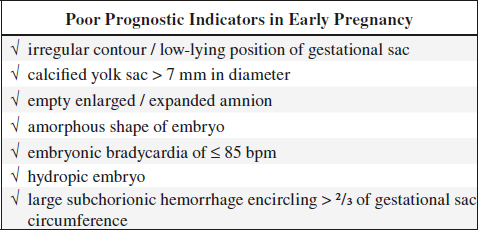
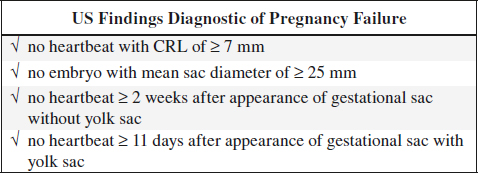
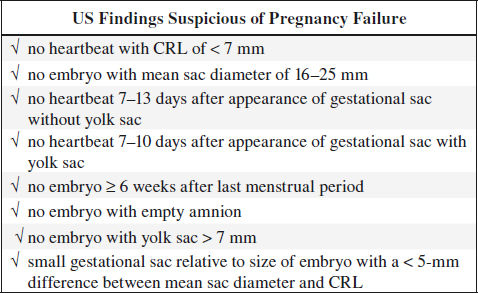
Abnormal Sonographic Findings in 1st Trimester
1. Embryonic demise = abortion (clinical term)
2. Nondevelopment = blighted ovum
3. Maldevelopment = hydatidiform mole
Empty Gestational Sac
1. Normal early IUP between 5 and 7 weeks MA
2. Blighted ovum
DDx: Pseudosac of ectopic pregnancy
Gestational Sac in Low Position
1. Abortion in progress
√ no placental blood flow
2. Cervical ectopic pregnancy
3. Fundal fibroid compressing sac downward
Pregnancy of Unknown Location
= normal pelvic US = transient state of early pregnancy during which no definite IUP is visualized at US with normal adnexa
= positive β-hCG without IUP
mnemonic: HERE
HCG-producing tumor (rare)
Ectopic pregnancy: occult
Recent completed spontaneous abortion
Early intrauterine pregnancy
In a hemodynamically stable patient with a pregnancy of unknown location, it is less harmful to wait, follow the β-hCG levels, and repeat the US examination than to presumptively treat an ectopic pregnancy.
hCG-producing Tumor
1. Gestational trophoblastic disease: hydatidiform mole, gestational choriocarcinoma
2. Ovarian malignant germ cell tumor
3. Nontesticular teratoma
4. Nontrophoblastic tumor: hepatoma, neuroendocrine tumor, breast cancer, pancreatic cancer, cervical cancer, gastric cancer, malignant phyllodes tumor
5. Spurious laboratory finding
Thickened Central Cavity Complex
1. Intrauterine blood
2. Retained products of conception following an incomplete spontaneous abortion
3. Early intrauterine not yet visible pregnancy
4. Decidual reaction ← ectopic pregnancy
Uterus Large for Dates
1. Multiple gestation pregnancy
2. Inaccurate menstrual history
3. Fibroids
4. Polyhydramnios
5. Hydatidiform mole
6. Fetal macrosomia
Intrauterine Membrane in Pregnancy
A. MEMBRANE OF MATERNAL ORIGIN
1. Uterine septum
= incomplete resorption of sagittal septum between the fused two müllerian ducts
2. Amniotic sheet / shelf
= folding of amniochorionic membrane around uterine synechia
√ synechia often thins during uterine stretching + disappears as pregnancy progresses
3. Wisps of umbilical cord
B. MEMBRANE OF FETAL ORIGIN
1. Intertwin membrane
= apposing membrane of multiple pregnancy / residual sac of blighted twin pregnancy
2. Amniotic band
= rent within amnion
3. Chorioamnionic separation
= incomplete fusion / hemorrhagic separation of amnion (= inner membrane) and chorion (= outer membrane)
4. Subchorionic hemorrhage = chorioamnionic elevation
= separation of chorionic membrane from decidua
• implantation bleed of early pregnancy
C. FIBRIN STRAND
Cause: hemorrhage during transplacental amniocentesis
mnemonic: STABS
Separation (chorioamnionic)
Twins (intertwin membrane)
Abruption
Bands (amniotic band syndrome)
Synechia
Dilated Cervix
1. Inevitable abortion
2. Premature labor
= spontaneous onset of palpable, regularly occurring uterine contractions between 20 and 37 weeks MA
3. Incompetent cervix
PLACENTA
Abnormal Placental Size
◊ Placental mass tends to reflect fetal mass!
A. ENLARGEMENT OF PLACENTA = Placentomegaly
= > 5 cm thick in sections obtained at right angles to long axis of placenta
(a) maternal disease
1. Maternal diabetes ← villous edema
2. Chronic intrauterine infections: eg, syphilis
3. Maternal anemia: normal histology
4. Alpha-thalassemia
(b) fetal disease
1. Hemolytic disease of the newborn ← villous edema + hyperplasia ← immunologic incompatibility including Rh sensitization
2. Umbilical vein obstruction
3. Fetal high-output failure:
large chorioangioma, arteriovenous fistula
4. Fetal malformation:
Beckwith-Wiedemann syndrome, sacrococcygeal teratoma, chromosomal abnormality, fetal hydrops
5. Twin-twin transfusion syndrome
(c) fetomaternal hemorrhage
(d) placental abnormalities
1. Molar pregnancy
2. Chorioangioma
3. Intraplacental hemorrhage
mnemonic: HAD IT
Hydrops
Abruption
Diabetes mellitus
Infection
Triploidy
B. DECREASE IN PLACENTAL SIZE
1. Preeclampsia: associated with placental infarcts in 33–60%
2. IUGR
3. Chromosomal abnormality
4. Intrauterine infection
Vascular Spaces of the Placenta
1. “Placental cysts”
= large fetal veins located between amnion + chorion anastomosing with umbilical vein
√ sluggish blood flow (detectable by real-time observation)
2. Basal veins
= decidual + uterine veins
√ lacy appearing network of veins underneath placenta
DDx: placental abruption
3. Intraplacental venous lakes
√ intraplacental sonolucent spaces
√ whirlpool motion pattern of flowing blood
Placental Causes of Antepartum Hemorrhage
= vaginal bleeding between 20 wks GA and delivery
1. Placenta previa
2. Placental abruption = placental hematoma
› on fetal side
(a) Subchorionic = preplacental hematoma
› on maternal side
(b) Retroplacental hematoma
(c) Intraplacental hematoma
Macroscopic Lesion of the Placenta
1. Intervillous thrombosis (36%)
= intraplacental areas of hemorrhage
Etiology: breaks in villous capillaries with bleeding from fetal vessels
√ irregular sonolucent intraplacental lesions (mm to cm range)
√ blood flow may be observed within lesion
Significance: fetal-maternal hemorrhage (Rh sensitization, elevated AFP levels)
2. Perivillous fibrin deposition (22%)
= nonlaminated collection of fibrin deposition
Etiology: thrombosis of intervillous space
Significance: none
3. Septal cyst (19%)
Etiology: obstruction of septal venous drainage by edematous villi
√ 5–10-mm cyst within septum
Significance: none
4. Placental infarct (25%)
= coagulation necrosis of villi
Etiology: disorder of maternal vessels, retroplacental hemorrhage
√ not visualized unless hemorrhagic
√ well-circumscribed mass with hyperechoic / mixed echo pattern
Significance: dependent on extent + associated maternal condition
5. Subchorionic fibrin deposition (20%)
= laminated collection of fibrin deposition
Etiology: thrombosis of maternal blood in subchorionic space
√ subchorionic sonolucent area
Significance: none
6. Massive subchorial thrombus
= BREUS MOLE = PREPLACENTAL HEMORRHAGE
Placental Tumor
A. TROPHOBLASTIC
1. Complete hydatidiform mole
2. Partial hydatidiform mole
3. Invasive mole
4. Choriocarcinoma
B. NONTROPHOBLASTIC
1. Chorioangioma (in up to 1% of placentas)
2. Teratoma (rare)
3. Metastatic lesion (rare): melanoma, breast carcinoma, bronchial carcinoma
Unbalanced Intertwin Transfusion
= unbalanced intertwin transfusion through vascular anastomoses between 2 circulations of monochorionic twins
A. ACUTE = Twin-embolization syndrome
B. CHRONIC = Twin-twin transfusion syndrome
C. REVERSE = Acardiac twinning
UMBILICAL CORD
Abnormal Umbilical Cord Insertion
1. Marginal cord insertion
= cord insertion < 1–2 cm from placental edge
Frequency: 5–7% of pregnancies
2. Battledore placenta
[battledore = flat wooden paddle in ancient form of badminton]
= cord insertion on edge of placenta = extreme marginal
• no clinical significance
3. Velamentous cord insertion
4. Vasa previa
Distortion Abnormality of Umbilical Cord
1. Cord torsion
= excessive twisting of cord as rare form of cord constriction
Timing: any time during pregnancy; more common during 2nd and 3rd trimester
√ evaluation of pitch value of cord coiling
√ abnormal S/D flow velocity ratio of umbilical artery
Cx: critically reduced fetal blood flow and fetal hypoxia, oligohydramnios, IUGR, and fetal death
Dx: difficult to diagnose prenatally; mostly detected during postnatal examination
2. Cord entanglement
Cause: nearby umbilical cord insertions on single placenta in monoamniotic twin pregnancy
√ branching pattern at level of entanglement
√ end systolic notch on umbilical artery waveform ← vascular compression / narrowing
Cx: vascular compromise in one / both fetuses → fetal demise
3. Noncoiled “straight” cord
counterclockwise÷clockwise umbilical cords = 7÷1
right-handed÷left-handed persons = 7÷1
Prevalence: 3.7–5%
√ absent vascular coiling for entire length of visible cord
At risk for: intrauterine death (8%), stillbirth, fetal anomalies (24%), prematurity, intrapartum heart rate decelerations, fetal distress, meconium staining
4. Body cord
= loop around fetal body / any fetal body part
5. Nuchal cord
Umbilical Cord Lesion
A. DEVELOPMENTAL CORD LESION
= protrusion from anterior abdominal wall with normal insertion of umbilical vessels
Predisposed:
Blacks, low-birth-weight infants, trisomy 21, congenital hypothyroidism, Beckwith-Wiedemann syndrome, mucopolysaccharidoses
Prognosis: spontaneous closure in first 3 years of life
2. Umbilical cord cyst
B. ACQUIRED CORD LESION
1. False knot
(a) exaggerated looping of cord vessels → focal dilatation of cord
(b) focal accumulation of Wharton jelly
(c) varix of umbilical vessel
• clinically insignificant
√ knoblike protrusion / bulge of cord
2. True knot
Prevalence: 1% of pregnancies
Cause: excessive fetal movements
Predisposed: long cord, polyhydramnios, small fetus, monoamniotic twins
√ “hanging noose” sign = segment of umbilical cord closely surrounded by another loop of cord
√ local distension / thrombosis of umbilical vein near cord knot resembling an umbilical cyst
√ tortuosity of cord at level of knot
Cx: vascular occlusion → fetal asphyxia → fetal demise
OB management: expectant (mostly loose knot with marginal impact on fetal well-being)
3. Umbilical cord hematoma
= rupture of the wall of the umbilical vein ← mechanical trauma (cordocentesis, torsion, loops, knots, traction) / congenital weakness of vessel wall
Prevalence: 0.02% of pregnancies
Location: near fetal insertion of umbilical cord (most common)
√ hyper- / hypoechoic mass 1–2 cm in size, multiple (in 18%)
Cx: rupture into amniotic cavity → exsanguination
Prognosis: 52% overall perinatal fetal mortality
4. Neoplasm
(a) Angiomyxoma / hemangioma of cord
Prevalence: 22 cases in literature
Histo: multiple vascular channels lined by benign endothelium surrounded by edema + myxomatous degeneration of Wharton jelly
Associated with: single umbilical artery
• increased maternal serum α-fetoprotein level
Location: more frequently near placental insertion of umbilical cord
√ hyperechoic / multicystic mass within cord
√ may be associated with pseudocyst (= localized collection of edema)
√ blood flow on Doppler
Cx: premature delivery, stillbirth, hydramnios, nonimmune hydrops, massive hemorrhage ← rupture
(b) Other tumors: myxosarcoma, dermoid, teratoma
Umbilical Cord Cyst
◊ Umbilical cord cysts persisting into 2nd + 3rd trimester are frequently accompanied by fetal anomalies: angiomyxoma of cord, hernia, intestinal obstruction, urinary tract obstruction, urachal anomalies, imperforate anus, TE fistula, omphalocele, cardiac defect, trisomy 18
Location: toward fetal insertion of cord
A. UMBILICAL CORD PSEUDOCYST (common)
= Mucoid degeneration of umbilical cord
= Wharton jelly cyst
Histo: localized edema + liquefaction of Wharton jelly without epithelial lining
Commonly associated with: omphalocele
√ focal thickening of Wharton jelly
Prognosis: usually resolved by 12 weeks MA
B. TRUE UMBILICAL CORD CYST (rare)
Prevalence: 3.4% of 1st trimester pregnancies; 20% persist into 2nd trimester
Histo: lined by single layer of flattened epithelium
Rarely associated with: fetal structural anomaly, aneuploidy
Size: 4–60 mm in diameter
1. Omphalomesenteric duct cyst
Site: eccentric in cord
2. Allantoic cyst
= remnant of umbilical vesicle / allantois; usually degenerates by 6 weeks
Site: in center of cord
3. Amniotic inclusion cyst
= amniotic epithelium trapped within umbilical cord
Vascular Abnormalities of Umbilical Cord
1. Single umbilical artery
2. Persistent Right Umbilical Vein (PRUV)
= regression of left umbilical vein → abnormal course of blood flow in fetal liver
Frequency: 0.1–0.3%
Cause: altered development of umbilical cord during 4th –7th week GA
May be associated with: situs inversus, heterotaxy, anomalies of GU / GI tract, heart, skeletal development
Path of blood flow:
(a) intrahepatic PRUV = isolated right umbilical vein joins fetal portal system at sinus venosus + gives rise to ductus venosus
(b) extrahepatic PRUV = right umbilical vein bypasses liver and drains into RA / IVC / right iliac vein + absent ductus venosus
√ fetal portal vein curves toward (rather than parallel to) stomach
√ fetal gallbladder between umbilical vein and stomach + medial (rather than lateral) to umbilical vein
√ umbilical vein connects to right (rather than left) portal vein
3. Umbilical vein / Cord varix
Frequency: < 4% of all umbilical cord abnormalities
May be associated with: aneuploidy (6%), other fetal anomalies (28%)
Site: intraamniotic / intraabdominal, intrahepatic / extrahepatic
Normal size of umbilical vein: 3 mm at 15 weeks GA, 8 mm at term
√ fusiform dilatation of umbilical vein > 9 mm
√ transverse diameter of extrahepatic umbilical vein > 1.5 x greater than intrahepatic component
√ vein diameter > 2 SD above mean diameter for GA
√ fetal hydrops, anemia, IUGR
| Cx: | (1) Thrombosis with subsequent fetal death |
(2) Partial thrombosis with IUGR |
◊ Serial US examinations are recommended from diagnosis to delivery!
Prognosis: usually no clinical significance
4. Umbilical artery aneurysm Often associated with single umbilical artery, aneuploidy, fetal structural abnormalities
SMALL-FOR-GESTATIONAL AGE FETUS (SGA)
= generic clinical term describing a group of perinates at / below 10th percentile for gestational age without reference to etiology
1. Fetus of appropriate growth (misdiagnosed as small)
2. Small normal fetus = constitutionally small fetus (80–85%)
◊ No indication for surveillance / intervention!
3. Small abnormal fetus = primary growth failure associated with karyotype anomaly / fetal infection (5–10%)
◊ Active intervention is of no benefit!
4. Dysmature fetus = IUGR = growth failure as a result of uteroplacental insufficiency (10–15%)
◊ Intensive management is likely of benefit!
FETAL OVERGROWTH DISORDER
1. Beckwith-Wiedemann syndrome
2. Simpson-Golabi-Behmenl syndrome
3. Perlman syndrome
FETAL SKELETAL DYSPLASIA
= DWARFISM
= heterogeneous group of bone growth disorders resulting in abnormal shape + size of the skeleton
◊ More than 200 skeletal dysplasias are known, but only a few are frequent:
› thanatophoric dysplasia
› osteogenesis imperfecta type II
› achondrogenesis
› heterozygous achondroplasia
Birth prevalence:
2.3÷10,000–7.6÷10,000 births for all skeletal dysplasias; 1.5÷10,000 births for lethal skeletal dysplasias
Prognosis: 51% mortality ← hypoplastic lungs: 23% stillbirths, 32% death in 1st week of life
Terminology:
| Amelia | = | absence of limb |
| Hemimelia | = | absence of distal parts |
| Micromelia | = | shortening involves entire limb (eg, humerus, radius + ulna, hand) |
| Rhizomelia | = | shortening involves proximal segment (ie, humerus / femur) |
| [rhiza, Greek = root of extremity = shoulder / hip] | ||
| Mesomelia | = | shortening involves intermediate segment (ie, radius + ulna / tibia + fibula) |
| [mesos, Greek= middle] | ||
| Acromelia | = | shortening involves distal segment (eg, hand) |
| Meromelia | = | partial absence of a limb |
| Phocomelia | = | proximal reduction with distal parts attached to trunk |
| Preaxial polydactyly | = | extra digit on radial / tibial side |
| Postaxial polydactyly | = | extra digit on ulnar / fibular side |
Classification:
(1) OSTEOCHONDRODYSPLASIA
= abnormalities of cartilage / bone growth and development
(a) identifiable at birth:
› usually lethal: achondrogenesis, fibrochondrogenesis, thanatophoric dysplasia, short rib syndrome
› usually nonlethal: chondrodysplasia punctata, camptomelic dysplasia, achondroplasia, diastrophic dysplasia, chondroectodermal dysplasia, Jeune syndrome, spondyloepiphyseal dysplasia congenita, mesomelic dysplasia, cleidocranial dysplasia, otopalatodigital syndrome
(b) identifiable in later life: hypochondroplasia, dyschondrosteosis, spondylometaphyseal dysplasia, acromicric dysplasia
(c) abnormal bone density: osteopetrosis, pyknodysostosis, Melnick-Needles syndrome
(2) DYSOSTOSIS
= malformation of individual bones singly / in combination
(a) with cranial + facial involvement: craniosynostosis, craniofacial dysostosis (Crouzon), acrocephalosyndactyly, acrocephalopolysyndactyly, branchial arch syndromes (Treacher-Collins, Franceschetti, acrofacial dysostosis, oculoauriculo-vertebral dysostosis, hemifacial microsomia, oculomandibulofacial syndrome)
(b) with predominant axial involvement: vertebral segmentation defects (Klippel-Feil), Sprengel anomaly, spondylocostal dysostosis, oculovertebral syndrome
(c) with predominant involvement of extremities: acheiria (= absence of hands), apodia (= absence of feet), polydactyly, syndactyly, camptodactyly, Rubinstein-Taybi syndrome, pancytopenia-dysmelia syndrome (Fanconi), Blackfan-Diamond anemia with thumb anomaly, thrombocytopenia-radial aplasia syndrome, cardiomelic syndromes (Holt-Oram), focal femoral deficiency, multiple synostoses
(3) IDIOPATHIC OSTEOLYSIS
= disorders with multifocal resorption of bone
(4) CHROMOSOMAL ABERRATION
(5) PRIMARY METABOLIC DISORDER
(a) calcium / phosphorus: hypophosphatasia
(b) complex carbohydrates: mucopolysaccharidosis
Assessment of:
1. Long bones for absence, hypoplasia, malformation, curvature, degree of mineralization, fractures, premature ossification centers
√ shortening of long bones (common characteristic)
◊ Femur length > 5 mm below 2 standard deviations suggests skeletal dysplasia!
√ FL÷foot length < 0.9 = suggests skeletal dysplasia
√ limb shortening of 40–60% of the mean in thanatophoric dysplasia + OI type II
√ limb shortening of > 30% of the mean in achondrogenesis
2. Thorax for shape, abnormal rib size, absence / hypoplasia of clavicles, presence of scapula
√ Chest Circumference < 5th percentile (= lung hypoplasia)
√ Chest Circumference÷AC < 5th percentile
√ heart area÷chest area < 5th percentile
√ FL÷AC < 0.16 = suggests lung hypoplasia
2. Hand & foot for clinodactyly, syndactyly, pre- or postaxial polydactyly
√ “hitchhiker’s thumb”, radial ray anomaly, absence of thumb
√ “rocker-bottom” foot, clubbed foot
4. Skull for size, shape (brachycephaly, scaphocephaly, craniosynostosis, frontal bossing, cloverleaf skull), degree of mineralization
√ HC and BPD
√ binocular and interocular diameter
√ micrognathia, short upper lip, abnormally shaped ears
4. Spine for relative total length, scoliosis, mineralization of vertebral bodies, integrity of neural arches, vertebral height, absence of segments
5. Pelvis for shape
Associated with: polyhydramnios
DDx features: mineralization, bowing, fractures, number of digits, fetal movement, thoracic measurement, associated anomalies, age of onset
DDx: constitutionally short limbs, severe IUGR
Micromelic Dwarfism
= disproportionate shortening of entire leg
A. Mild micromelic dwarfism
1. Jeune syndrome
2. Chondroectodermal dysplasia
3. Diastrophic dwarfism
B. Mild bowed micromelic dwarfism
1. Camptomelic dysplasia
2. Osteogenesis imperfecta, type III
C. Severe micromelic dwarfism
1. Thanatophoric dysplasia
2. Osteogenesis imperfecta, type II
3. Homozygous achondroplasia
4. Hypophosphatasia
5. Short-rib polydactyly syndrome
6. Fibrochondrogenesis
Acromelic Dwarfism
Asphyxiating thoracic dysplasia
Rhizomelic Dwarfism
mnemonic: MA CAT
Metatrophic dwarfism
Achondrogenesis (most severe shortening)
Chondrodysplasia punctata: autosomal recessive
Achondroplasia, heterozygous
Thanatophoric dysplasia
Osteochondrodysplasia
A. Failure of
(a) articular cartilage: spondyloepiphyseal dysplasia
(b) ossification center: multiple epiphyseal dysplasia
(c) proliferating cartilage: achondroplasia
(d) spongiosa formation: hypophosphatasia
(e) spongiosa absorption: osteopetrosis
(f) periosteal bone: osteogenesis imperfecta
(g) endosteal bone: idiopathic osteoporosis
B. Excess of
(a) articular cartilage: dysplasia epiphysealis hemimelica
(b) hypertrophic cartilage: enchondromatosis
(c) spongiosa: multiple exostosis
(d) periosteal bone: progressive diaphyseal dysplasia
(e) endosteal bone: hyperphosphatemia
Lethal Bone Dysplasia
in order of frequency:
1. Thanatophoric dysplasia
2. Osteogenesis imperfecta type II
3. Achondrogenesis type I + II
4. Jeune syndrome (may be nonlethal)
5. Hypophosphatasia, congenital lethal form
6. Chondroectodermal dysplasia (usually nonlethal)
7. Chondrodysplasia punctata, rhizomelic type
8. Camptomelic dysplasia
9. Short-rib polydactyly syndrome
10. Homozygous achondroplasia
◊ Lethal short-limbed dysplasias typically are manifest on sonograms < 24 weeks MA!
Nonlethal Dwarfism
1. Achondroplasia (heterozygous)
2. Asphyxiating thoracic dysplasia
3. Chondroectodermal dysplasia
4. Chondrodysplasia punctata
5. Spondyloepiphyseal dysplasia (congenital)
6. Diastrophic dysplasia
7. Metatrophic dwarfism
8. Hypochondroplasia
Late-onset Dwarfism
1. Spondyloepiphyseal dysplasia tarda
2. Multiple epiphyseal dysplasia
3. Pseudoachondroplasia
4. Metaphyseal chondrodysplasia
5. Dyschondrosteosis
6. Cleidocranial dysostosis
7. Progressive diaphyseal dysplasia
Hypomineralization in Fetus
A. DIFFUSE
1. Osteogenesis imperfecta
2. Hypophosphatasia
B. SPINE
1. Achondrogenesis
Large Head in Fetus
1. Achondroplasia
2. Thanatophoric dysplasia
Narrow Hypoplastic Chest in Fetus
1. Short-rib polydactyly syndrome
2. Asphyxiating thoracic dysplasia
3. Chondroectodermal dysplasia
4. Camptomelic dysplasia
5. Thanatophoric dysplasia
6. Homozygous achondroplasia
7. Achondrogenesis
8. Hypophosphatasia
9. Osteogenesis imperfecta
Platyspondyly
1. Thanatophoric dysplasia
2. Osteogenesis imperfecta type II
3. Achondroplasia
4. Morquio syndrome
Bowed Long Bones in Fetus
1. Camptomelic syndrome
2. Osteogenesis imperfecta
3. Thanatophoric dysplasia
4. Hypophosphatasia
Bone Fractures in Fetus
1. Osteogenesis imperfecta
2. Hypophosphatasia
3. Achondrogenesis
Acrocephalosyndactyly
= syndrome characterized by
(1) increased height of skull vault ← generalized craniosynostosis (= acrocephaly, oxycephaly)
(2) syndactyly of fingers / toes
Type 1: Apert syndrome
Type 2: Crouzon syndrome
Type 3: Saethre-Chotzen syndrome
Type 4: Wardenburg type
Type 5: Pfeiffer syndrome
Acrocephalopolysyndactyly
Type 1: Noack syndrome
Type 2: Carpenter syndrome
Type 3: Sakati-Nyhan-Tisdale syndrome
Type 4: Goodman syndrome
Type 5: Pfeiffer syndrome
LIMB REDUCTION ANOMALIES
Prevalence: 0.49 ÷10,000 births
Isolated Extremity Amputation
1. Amniotic band syndrome
2. Exposure to teratogen
3. Vascular accident
Aplasia / Hypoplasia of Radius
mnemonic: The Furry Cat Hit My Dog
Thrombocytopenia–absent radius syndrome
Fanconi anemia
Cornelia de Lange syndrome
Holt-Oram syndrome
Myositis ossificans progressiva (thumb only)
Diastrophic dwarfism (“hitchhiker’s thumb”)
Pubic Bone Maldevelopment
mnemonic: CHIEF
Cleidocranial dysostosis
Hypospadia, epispadia
Idiopathic
Exstrophy of bladder
F for syringomyelia
Fetal Hand Anomalies
Best time for assessment:
late 1st to middle 2nd trimester ← ossification of metacarpals beginning at 12 weeks EGA + frequent fetal movement
◊ Complete fetal work-up needed for associated anomalies!
Normal findings:
› unossified hypoechogenic carpus
› 5 hyperechoic + cylindric metacarpal bones
› 5 independent digits of different lengths with 3 ossified phalanges (2 for thumb)
› normal radius, ulna, humerus
› flexion (fist) + extension (unclenched hand)
Classification:
(a) abnormal alignment: clenched hand, camptodactyly, clinodactyly, akinesia deformation sequence, clubhand, phocomelia
(b) thumb anomalies: macrodactyly, trident hand
(c) abnormal number: polydactyly, syndactyly, ectrodactyly
Camptodactyly
= flexion contracture of PIP joint of any finger
Cause: karyotype anomaly (trisomy 18, 13, 15) or contracture syndrome; may be isolated
Location: often asymmetric
Prognosis: may progress during infancy / childhood
Clenched Hand
= index finger overlaps clenched fist formed by other digits
Cause: trisomy 18, akinesia-hypokinesia syndromes, temporarily closed normal fist
√ proximal interphalangeal articulation of index finger flexed + ulnarly deviated
√ adducted thumb
Clinodactyly
= fixed abnormal deviation of 5th finger in radioulnar plane (= radial angulation of DIP joint) ← abnormally small size of middle phalanx
Cause: trisomy 21 (in up to 60%), triploidy; isolated familial clinodactyly; normal in 18%
Clubhand
= permanently deviated axis of wrist + usually closed hand
Classification:
(a) Radial clubhand associated with preaxial deficits (ranging from mild hypoplasia of thumb to complete absence of radius)
(b) Ulnar clubhand ← ulnar deficiency
Ectrodactyly
= SPLIT / CLEFT HAND = LOBSTER CLAW HAND
= longitudinal deficiency of central digits
Cause: EEC (ectrodactyly, ectodermal dysplasia, cleft lip or palate), Roberts syndrome
Pathogenesis: failure of median apical ectodermal ridge in developing limb bud
May be associated with: syndactyly, aplasia, hypoplasia of residual phalanges + metacarpals
√ deep V- or U-shaped central defect
DDx: oligodactyly (= reduced number of well-formed fingers), constrictive amniotic bands
Macrodactyly
= overgrowth of all structures of affected (commonly radial) fingers
Cause: proteus syndrome, neurofibromatosis type 1
Phocomelia
= missing / foreshortened arm / forearm with presence of hand
Cause:
(1) Thalidomide
(2) Roberts syndrome = autosomal recessive disorder associated with tetraphocomelia with more severe upper-limb deformities, facial cleft, polyhydramnios
(3) TAR syndrome
(4) Grebe syndrome = autosomal recessive disorder associated with marked hypomelia (more severe in lower limbs increasing in severity distally)
Polydactyly
= presence of supernumerary digits
Incidence: 1÷683 pregnancies;
◊ Most common hand anomaly!
Cause: trisomy 13, short-rib-polydactyly syndrome, asphyxiating thoracic dystrophy (Jeune syndrome), Smith-Lemli-Opitz syndrome
ULNAR / POSTAXIAL POLYDACTYLY (more frequent)
affecting 5th finger
Cause:
(1) Trisomy 13
(2) Meckel-Gruber syndrome
(3) Short-rib polydactyly syndrome
(4) Ellis-van Creveld syndrome
(5) Smith-Lemli-Opitz syndrome (= intrauterine growth retardation + characteristic high level of 7-dehydrocholesterol)
(6) Hydrolethalus syndrome (= heart and brain defects, cleft lip / palate, abnormally shaped nose / jaw, incomplete lung development causing stillbirth / death within a few days after birth)
(7) Bardet-Biedl syndrome = medullary cystic kidney disease without encephalocele, progressive renal dystrophy, obesity, hypogonadism, learning difficulties
RADIAL / PREAXIAL POLYDACTYLY (less frequent)
affecting thumb
Cause:
(1) Holt-Oram syndrome
(2) Short-rib–polydactyly syndrome
(3) Carpenter syndrome
(4) Trisomy 21
(5) VACTERL association
(6) Fanconi anemia
(7) Orodigitofacial syndrome
POLYSYNDACTYLY
= association of polydactyly with syndactyly
Syndactyly
= abnormal connection between adjacent digits
Incidence: 2–3÷10,000 live births
Location: commonly between 2nd + 3rd digit
Classification: simple (between soft tissues), complex (between bones), complete (entire length of finger), incomplete (sparing of distal part)
Cause: Poland sequence, Apert syndrome and other acrocephalosyndactylies, triploidy, Roberts syndrome, familial syndactyly (autosomal dominant, with variable expressivity and incomplete penetrance), constriction band sequence
Trident Hand
= same length of last 4 fingers
Cause: various chondrodysplasias
Overlapping Digit
trisomy 18
Hitchhiker’s Thumb
diastrophic dysplasia
Flexion Contractures
trisomy 13 + 18, fetal akinesia deformation sequence
Limb Reduction
congenital varicella, hypoglossia-hyperdactyly syndrome
Amputation
amniotic band syndrome
Drug-induced Musculoskeletal Embryopathy
Thalidomide
= sedative-hypnotic nonbarbiturate (sold 1954–1961)
Critical period: 34–50 days after most recent menstrual period
• increased miscarriage, increased stillbirth rate
• 40% increased infant mortality
√ narrowing, disorganization, destruction of joints
√ hemimelia = absence / gross shortening of distal portion of one / more limbs (esp. radius + thumb)
√ phocomelia = attachment of hands + feet to abbreviated arms and legs
√ amelia = congenital absence of one / more arms / legs
√ fusion / absence of paired bones
Anticonvulsant Drugs
Prevalence: 0.4% of pregnancies
Drugs: valproic acid, carbamazepine, phenytoin, phenobarbital
√ diminished bone mineral density
√ poorly developed diaphyses of long bones
√ anomalies of phalanges:
√ hypoplastic terminal phalanges associated with dysplastic nails
√ hyperphalangism
√ congenital heart disease, cleft lip + palate, urinary tract anomalies, syndromes of dysmorphism, mental retardation
Folic Acid Antagonists
Drugs: aminopterin, methotrexate
Critical period: 6–8 weeks after conception
√ growth retardation
√ osteoporosis
√ talipes equinovarus, foreshortened extremities, absent digits, syndactyly, anomalous ribs
√ CNS anomalies, cardiac abnormalities
Vitamin A and Retinoids
• anomalies of external ear, facial dysmorphism
√ CNS, craniofacial, cardiovascular, thymic malformations
√ hydrocephalus, microcephalus
Warfarin
Critical period: 6–9 weeks GA
Frequency: 10%
√ stippled ossification centers in vertebrae, proximal femora, tarsal + carpal bones
FETAL CNS ANOMALIES
Prevalence: 2÷1,000 births in USA; 90% as 1st time occurrence
Recurrence: 2–3% after 1st, 6% after 2nd occurrence
√ ventricular atrium + cisterna magna are two sensitive anatomic markers for normal brain development!
A. HYDROCEPHALUS
1. Aqueductal stenosis
2. Communicating hydrocephalus
3. Dandy-Walker malformation
4. Choroid plexus papilloma
B. NEURAL TUBE DEFECT
Prevalence: 1÷500–600 live births
Risk of recurrence: 3–4%
1. Spina bifida
2. Anencephaly
3. Acrania
4. Encephalocele (8–15%)
5. Porencephaly
6. Hydranencephaly
7. Holoprosencephaly
8. Iniencephaly
9. Microcephaly
10. Agenesis of corpus callosum
11. Lissencephaly
12. Arachnoid cyst
13. Choroid plexus cyst
14. Vein of Galen aneurysm
15. Schizencephaly
Associated with: trisomy 13 and 18
Increased risk: low parity, low socioeconomic status, relative infertility, diabetes, obesity, anticonvulsants, folate deficiency
C. INTRACRANIAL NEOPLASM
1. Teratoma (> 50%): benign / malignant
Location: originate from base of skull
3. Astrocytoma
Fetal Ventriculomegaly
Cause:
A. MORPHOLOGIC ANOMALY (70–80%):
1. Spina bifida (30–65%)
2. Dandy-Walker malformation
3. Encephalocele
4. Holoprosencephaly
5. Agenesis of corpus callosum
B. ABNORMAL KARYOTYPE (10–20%)
C. VIRAL INFECTION
◊ 20–40% of concurrent anomalies are missed by ultrasound!
√ “dangling” choroid plexus
√ width of ventricular atrium > 10 mm
Prognosis: 21% survival rate; 50% with intellectual impairment
Isolated Mild Ventriculomegaly
= atrial width of 10–15 mm
Prevalence: 1÷700 in low-risk population
◊ Most common brain anomaly on prenatal sonograms
Associated structural anomalies (9%):
periventricular leukomalacia, subependymal / germinal matrix hemorrhage, partial agenesis of corpus callosum, heterotopia, parenchymal dysplasia
Associated chromosomal anomalies: in 4%
Recommendation: MR to diagnose associated structural anomalies
Prognosis: 80% with isolated mild ventriculomegaly have normal motor + intellectual function at ≥ 12 months of age
Lemon Sign
= flat / inwardly scalloped contour of both frontal bones
1. Spina bifida
Prevalence for fetuses ≤ 24 weeks: 98%
(90–93% sensitive, 98–99% specific, 84% PPV for high-risk population, 6% PPV for low-risk population)
Prevalence for fetuses > 24 weeks: 13%
(disappears in 3rd trimester)
2. Encephalocele
3. Agenesis of corpus callosum
4. Thanatophoric dysplasia
5. Cystic hygroma
6. Congenital diaphragmatic hernia
7. Fetal hydronephrosis
8. Umbilical vein varix
9. Normal fetus (in 0.7–1.3%)
Prenatal Intracranial Calcifications
1. Toxoplasmosis
2. CMV infection
3. Tuberous sclerosis
4. Sturge-Weber syndrome
5. Venous sinus thrombosis
6. Teratoma
Cystic Intracranial Lesion
mnemonic: CHAP VAN
Choroid plexus cyst
Hydrocephalus, Holoprosencephaly, Hydranencephaly
Agenesis of corpus callosum + cystic dilatation of 3rd ventricle
Porencephaly (= schizencephaly)
Vein of Galen aneurysm
Arachnoid cyst
Neoplasm: cystic teratoma
Abnormal Cisterna Magna
Normal size between 15 and 25 weeks MA:
> 2 to < 10 mm (usually 4–9 mm) in 94–97% of fetuses
A. SMALL CISTERNA MAGNA + “banana” sign
1. Chiari II malformation (with myelomeningocele)
2. Occipital cephalocele
3. Severe hydrocephalus
B. LARGE CISTERNA MAGNA
1. Megacisterna magna
√ cerebellum + vermis remain intact
2. Arachnoid cyst
√ en bloc displacement of cerebellum + vermis
3. Cerebellar hypoplasia
4. Dandy-Walker syndrome (with vermian agenesis)
FETAL ORBITAL ANOMALIES
Hypotelorism
1. Holoprosencephaly
2. Chromosomal abnormalities: trisomy 13
3. Microcephaly, trigonocephaly
4. Maternal phenylketonuria
5. Meckel-Gruber syndrome
6. Myotonic dystrophy
7. Williams syndrome
8. Oculodental dysplasia
Hypertelorism
1. Median cleft syndrome: cleft lip / palate
2. Craniosynostosis: Apert / Crouzon syndrome
3. Pena-Shokeir syndrome
4. Frontal / ethmoidal, sphenoidal encephalocele
5. Dilantin / phenytoin effect
Orbital and Periorbital Masses
1. Dacryocystocele
2. Anterior encephalocele
3. Glioma
4. Hemangioma
5. Teratoma
FETAL NECK ANOMALIES
1. Cervical myelomeningocele
2. Occipital cephalocele
3. Cystic hygroma / lymphangioma
4. Teratoma
5. Branchial cleft cyst
6. Enlarged thyroid
7. Sarcoma
Nuchal Skin Thickening
= NUCHAL SONOLUCENCY / FULLNESS / EDEMA
= skin thickening of posterior neck measured between calvarium + dorsal skin margin
(a) ≥ 3 mm during 9–13 weeks MA
(b) ≥ 5 mm during 14–21 weeks MA
(c) ≥ 6 mm during 19–24 weeks MA
◊ The smallest measurement should be used!
Image plane: axial / transverse image (slightly craniad to that of the BPD measurement) that includes cavum septi pellucidi, cerebellar hemisphere and cisterna magna (transcerebellar diameter view)
Prevalence: among the most common anomaly in 1st trimester + early 2nd trimester
Cause:
A. NORMAL VARIANT (0.06%)
B. CHROMOSOMAL DISORDERS trisomy 21 (in 45–80%), Turner syndrome (45 XO), Noonan syndrome, trisomy 18, XXX syndrome, XYY syndrome, XXXX syndrome, XXXXY syndrome, 18p-syndrome, 13q-syndrome
◊ 30–40% of fetuses with Down syndrome have nuchal skin thickening!
C. NONCHROMOSOMAL DISORDERS
1. Multiple pterygium syndrome = Escobar syndrome
2. Klippel-Feil syndrome: fusion of cervical vertebrae, CHD, deafness (30%), cleft palate
3. Zellweger syndrome = cerebrohepatorenal syndrome: large forehead, flat facies, macrogyria, hepatomegaly, cystic kidney disease, contractures of extremities
4. Robert syndrome
5. Cumming syndrome
√ larger lymphangiomas with radiating septations are usually found with trisomy 18
√ nuchal fullness ≥ 3 mm during 1st trimester is seen in trisomy 21 / 18 / 13 (30–50% PPV)
√ often reverting to normal by 16–18 weeks
√ septations within nuchal translucency carries a 20- to 200-fold risk for chromosomal anomalies compared with normal
Sensitivity: 2–44–75% for detection of trisomy 21
Specificity: 99% for detection of trisomy 21
PPV: 69%
Positive screen: 1.2–3.0% in general population (exceeding 0.5% risk of amniocentesis)
False positives: 0.5–2–8.5%
OB management: thorough sonographic evaluation at 18–20 weeks MA
DDx: chorioamnionic separation
Protruding Tongue
1. Macroglossia
2. Lymphangioma of the tongue
Macroglossia
1. Beckwith-Wiedemann syndrome
2. Down syndrome
3. Hypothyroidism
4. Mental retardation
FETAL CHEST ANOMALIES
Pulmonary Underdevelopment
Pulmonary Aplasia
= rudimentary bronchus ending in blind pouch + absence of parenchyma + vessels
Frequency: 1÷10,000; R÷L = 1÷1
CT:
√ diffuse opacification of involved hemithorax
√ ipsilateral mediastinal shift
√ absence of ipsilateral pulmonary tissue + artery
√ bronchus terminates in dilated short blind pouch
Pulmonary Hypoplasia
= completely formed but congenitally small bronchus with rudimentary parenchyma + small vessels
Cause:
A. PRIMARY / idiopathic pulmonary hypoplasia (rare)
B. SECONDARY pulmonary hypoplasia limiting space for lung development
(a) Intrathoracic lung compression
1. Intrathoracic mass
2. Mediastinal mass
3. Large hydrothorax
4. Lymphatic malformation
5. Agenesis of diaphragm
(b) Extrathoracic lung compression (= Potter syndrome)
1. Prolonged oligohydramnios (20–25%) ← renal agenesis, bilateral cystic renal disease, obstructive uropathy, premature rupture of membranes
2. Fetal ascites
(c) Dysplasia of thoracic cage
1. Jeune
2. Thanatophoric dystrophy
3. Ellis-van Creveld
4. Severe achondroplasia
(d) Others ← reduced breathing activity
1. Muscular disease
2. Neurologic condition
3. Chromosomal abnormality
Path: absolute decrease in lung volume / weight for GA
√ thoracic circumference (TC) < 5th percentile for EGA
√ TC÷AC length ratio < 0.32
√ FL÷AC ratio < 0.16
√ small hyperlucent lung ← oligemia
√ diminutive ipsilateral pulmonary artery
√ hyperlucent contralateral lung ← compensatory hyperexpansion
√ ipsilateral mediastinal shift
Congenital Chest Malformation
1. Congenital pulmonary airway malformation
2. Congenital diaphragmatic hernia (CDH)
3. Bronchopulmonary sequestration (BPS)
4. Congenital hydrothorax
5. Congenital lobar emphysema
6. Congenital high airway obstruction syndrome
Intrathoracic Mass
in order of frequency:
1. Congenital diaphragmatic hernia / eventration
2. Congenital pulmonary airway malformation
3. Bronchopulmonary sequestration
4. Bronchogenic cyst
5. Bronchial atresia
Unilateral Chest Mass
1. Congenital diaphragmatic hernia
2. Congenital pulmonary airway malformation
3. Bronchopulmonary sequestration
4. Bronchogenic cyst
5. Unilateral bronchial atresia / stenosis
Bilateral Chest Masses
1. Laryngeal / tracheal atresia
√ pulmonary hyperplasia
√ symmetrically enlarged echogenic lungs
√ dilated fluid-filled trachea + bronchi
√ inverted hemidiaphragms
√ diminutive heart amongst enlarged lungs
√ ± hydrops
2. Congenital high airway obstruction
2. Bilateral congenital pulmonary airway malformation
3. Bilateral congenital diaphragmatic herniae
Mediastinal Mass
1. Goiter
2. Cystic hygroma
3. Pericardial teratoma
4. Neuroblastoma
Cystic Chest Mass
1. Bronchogenic cyst
2. Enteric cyst
3. Neurenteric cyst
4. Cystic adenomatoid malformation type I
5. Congenital diaphragmatic hernia
6. Pericardial cyst
7. Mediastinal meningocele
Complex Chest Mass
1. Congenital diaphragmatic hernia
2. Congenital pulmonary airway malformation
3. Bronchopulmonary sequestration
4. Complex enteric cyst
5. Pericardial teratoma
Solid Chest Mass
1. Congenital diaphragmatic hernia: bowel ± liver
2. Cystic adenomatoid malformation type III
3. Pulmonary sequestration
4. Obstructed lung ← bronchial atresia, laryngeal atresia, bronchogenic cyst
5. Bronchopulmonary foregut malformation
6. Pericardial tumor
7. Heterotopic brain tissue
Regressing Fetal Chest Mass
1. Cystic adenomatoid malformation
2. Bronchopulmonary sequestration
Chest Wall Mass
1. Hemangioma
2. Cystic hygroma
3. Teratoma
4. Hamartoma
5. Thoracic myelomeningocele
Pleural Effusion
1. Primary idiopathic chylothorax (most common)
2. Hydrops fetalis (multiple causes)
3. Chromosome anomaly: trisomy 21, 45 XO (mostly)
4. Pulmonary lymphangiectasia / cystic hygroma
5. Lung mass: cystic adenomatoid malformation, bronchopulmonary sequestration, congenital diaphragmatic hernia, chest wall hamartoma (uncommon)
6. Pulmonary vein atresia
7. Idiopathic
FETAL CARDIAC ANOMALIES
Prevalence: 1÷125 births = 0.8% of population; most common of all congenital malformations (40%)
◊ 90% occur as isolated multifactorial traits with a recurrence risk of 2–4%
◊ 10% are associated with multiple birth defects
◊ responsible for 50% of childhood deaths from congenital malformations
Antenatal sonographic diagnosis to prompt cardiac evaluation:
A. ABNORMALITIES IN CARDIAC POSITION
B. CNS
1. Hydrocephalus
2. Microcephaly
3. Agenesis of corpus callosum
4. Encephalocele: Meckel-Gruber syndrome
C. GASTROINTESTINAL
1. Esophageal atresia
2. Duodenal atresia
3. Situs abnormalities
4. Diaphragmatic hernia
D. VENTRAL WALL DEFECT
1. Omphalocele
2. Ectopia cordis
E. RENAL
1. Bilateral renal agenesis
2. Dysplastic kidneys
F. TWINS
1. Conjoined twins
Prenatal Risk Factors for Congenital Heart Disease
A. FETAL RISK FACTORS
1. Symmetric IUGR
2. Arrhythmias
(a) fixed fetal bradycardia (50%) ≤ 110 bpm
(b) tachycardia (low risk)
(c) irregular: PACs, PVCs (low risk)
3. Abnormal fetal karyotype: CHD in Down syndrome (40%); in trisomy 18 / 13 (> 90%); in Turner syndrome (35%)
4. Extracardiac somatic anomalies by US: omphaloceles (20%), duodenal atresia, hydrocephaly, spina bifida, VACTERL
5. Nonimmune hydrops (30–35%)
6. Oligo- / polyhydramnios
B. MATERNAL RISK FACTORS
1. Maternal heart disease (10%)
2. Insulin-dependent diabetes mellitus (4–5%)
3. Phenylketonuria (in 15% if maternal phenylalanine > 15%)
4. Collagen vascular disease: SLE
5. Viral infection: rubella
6. Drugs
(a) phenytoin: in 2% PS, AS, coarctation, PDA
(b) trimethadione: in 20% transposition, tetralogy, hypoplastic left heart
(c) sex hormones (in 3%)
(d) lithium (7%): Ebstein anomaly, tricuspid atresia
(e) alcohol (25% of fetal alcohol syndrome): VSD, ASD
(f) retinoic acid = isotretinoin (?15%)
7. Paternal CHD (risk uncertain)
C. MENDELIAN SYNDROMES
1. Tuberous sclerosis
2. Ellis-van Creveld syndrome
3. Noonan syndrome
D. FAMILIAL RISK FACTORS FOR RECURRENCE OF HEART DISEASE
| › | overall incidence | : | 6–8÷1,000 live births |
| › | affected sibling | : | 1–4% (risk doubled) |
| › | affected parent | : | 2.5–4% |
Stay updated, free articles. Join our Telegram channel

Full access? Get Clinical Tree


